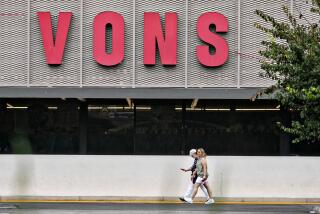Fast food easier to find than healthful fare, study says
- Share via
Fast food isn’t just fast; it’s also plentiful.
In California, people are more than four times as likely to find a fast-food restaurant or convenience store than a grocery or produce store, according to a study released today by the California Center for Public Health Advocacy.
The researchers say it’s a dangerous ratio in the face of an expanding national obesity crisis: It limits consumers’ choices to the convenient rather than the nutritious. Moreover, they say, some areas offer far fewer healthy choices than others.
“Where someone lives directly affects their chances of being overweight,” said Harold Goldstein, the center’s executive director. “In neighborhoods with fewer grocery stores than fast-food restaurants, the residents not only have higher obesity rates, but they also have higher rates of dying.”
The study created a “retail food environment index” for California communities. Los Angeles County’s ratio was 4.6, meaning it had nearly five times the number of fast-food and convenience stores than grocery or produce stores. San Bernardino, home to America’s first McDonald’s, had the highest ratio of any county in the state, 5.72. Marin and Santa Cruz, among the state’s most affluent counties, had the lowest, 1.85 and 1.84, respectively.
Based on its findings, the center recommended that communities offer incentives to increase the number of grocery stores and produce vendors and that they limit the number of fast-food restaurants and convenience stores. Further, it endorsed a requirement for providing nutritional information on fast-food menus and menu boards.
But Jordan Traverso, spokeswoman for the California Restaurant Assn., said it’s unfair to pit fast-food retailers against grocery stores.
“You’re comparing apples to paper bags,” she said. “They’re not even in the same category.”
Traverso said consumer demand determines the number of fast-food restaurants in an area, and that market research gauges whether opening such businesses would be profitable. Further, she said, fast-food restaurants are sensitive to customer tastes, and many now offer healthier menu items.
State Sen. Alex Padilla (D-Pacoima), who has sponsored a bill requiring restaurant chains to provide nutritional information on their menus, said people have a right to know what they’re eating. “It’s hard to make good choices without good information,” he said.
Most restaurant chains already provide that information in brochures or on their websites, Traverso said, and some customers simply choose not to read it.
Goldstein acknowledged that the industry “is doing a much better job” of helping customers live healthier lifestyles. But he said fast food is so pervasive in some places that consumers must go out of their way to make healthier choices.
“If I offered you cookies, you would have a choice to have some or not,” he said. “You wouldn’t say, ‘No, but I’ll have an orange.’ ”
More to Read
Eat your way across L.A.
Get our weekly Tasting Notes newsletter for reviews, news and more.
You may occasionally receive promotional content from the Los Angeles Times.










